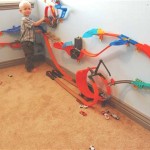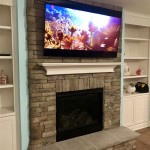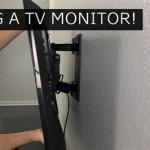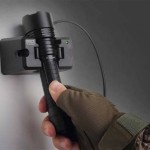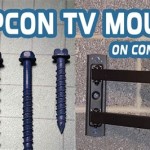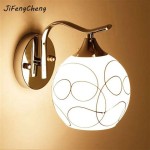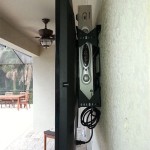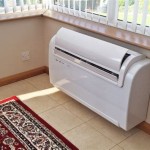Understanding Full Motion Wall Mount TV Brackets
Full motion wall mount TV brackets represent a versatile solution for optimizing viewing angles and maximizing space utilization in residential and commercial settings. These brackets, also known as articulating or extending mounts, offer a significant degree of flexibility compared to fixed or tilting models. The ability to move the TV horizontally, vertically, and even extend it away from the wall provides users with unparalleled control over their viewing experience. This article will explore the features, benefits, considerations, and installation aspects of full motion wall mount TV brackets.
The core principle behind a full motion wall mount lies in its multi-jointed arm design. This design allows the television to be pulled away from the wall, swivelled left or right, and sometimes tilted up or down. The level of movement afforded by these brackets can transform a static viewing point into a dynamic one, adapting to various seating arrangements and room layouts. This adaptability makes full motion mounts particularly advantageous in rooms with multiple viewing locations or where glare from windows is a concern.
The construction of a full motion wall mount typically involves heavy-duty steel or aluminum components. These materials are chosen for their strength and durability, ensuring the bracket can safely support the weight of the television. The arms are connected by pivot points or hinges, often incorporating friction mechanisms that allow for smooth and controlled movement while maintaining the desired position of the TV. The wall plate, which attaches directly to the wall, is a critical component that must be securely anchored to studs or a suitable mounting surface.
Key Benefits of Using Full Motion Wall Mounts
Full motion TV mounts offer a range of advantages that contribute to an enhanced viewing experience and improved room aesthetics. These benefits extend beyond simple space saving and provide users with greater control and flexibility.
One primary advantage is the enhanced viewing angle flexibility. The ability to swivel the TV left or right allows viewers to adjust the screen position to suit their seating location. This is particularly useful in open-plan living spaces where the TV might be viewed from the kitchen, dining area, or lounge. Furthermore, the tilt function can help to reduce glare from windows or overhead lighting, ensuring optimal image clarity regardless of the ambient light conditions. This adjustability caters to various needs depending on room configuration and time of day.
Another significant benefit is the ease of accessing the rear of the TV. Full motion mounts allow the television to be extended away from the wall, providing ample space to connect or disconnect cables. This is especially helpful for troubleshooting connection problems, upgrading devices, or managing cable clutter. Without the need to completely remove the TV from the wall, users can easily access the input ports and power connections, simplifying maintenance and device management. This feature is also advantageous when initially setting up the TV and connecting all the necessary peripherals.
Full motion mounts also contribute significantly to space saving and aesthetic appeal. By mounting the TV on the wall, valuable floor space is reclaimed, creating a more open and uncluttered environment. This is particularly beneficial in smaller rooms where space is at a premium. Hiding cables behind the wall also contributes to a cleaner, more organized look, enhancing the overall aesthetics of the room. The sleek design of many full motion mounts complements modern interior styles, adding a touch of sophistication to the viewing setup.
Factors to Consider When Choosing a Full Motion Wall Mount
Selecting the appropriate full motion wall mount requires careful consideration of several factors, including TV size and weight, VESA compatibility, wall structure, and range of motion. Overlooking these aspects can lead to installation difficulties, safety concerns, or limitations in the desired viewing experience.
The first and foremost consideration is the TV's size and weight. Full motion mounts are designed to support TVs within a specific weight range, and exceeding this limit can compromise the mount's structural integrity and potential cause damage to the TV or the wall. Before purchasing a mount, it is essential to consult the TV's specification sheet to determine its weight. It is also wise to factor in the weight of any connected devices, such as soundbars or streaming boxes, that might be attached to the TV.
VESA (Video Electronics Standards Association) compatibility is another crucial aspect. The VESA standard defines the spacing of the mounting holes on the back of the TV. Full motion mounts are designed to accommodate specific VESA patterns. It is essential to measure the VESA pattern on the TV and ensure that it is compatible with the chosen mount. Most full motion mounts support a range of VESA patterns, but it is always advisable to double-check compatibility to avoid installation issues. Adapters are available for some non-standard VESA patterns, but it is generally preferable to select a mount that directly supports the TV's VESA specifications.
The wall structure is a critical factor influencing the mounting process and the stability of the installation. Full motion mounts must be securely attached to wall studs or a reinforced wall surface. Mounting the bracket directly to drywall without proper support can result in the TV detaching from the wall. Using a stud finder to locate wall studs is essential, and when studs are not ideally positioned, a mounting plate or horizontal supports may be required to achieve a secure and stable installation. For concrete or masonry walls, specialized anchors are necessary to ensure a robust connection.
The desired range of motion should also be considered. Different full motion mounts offer varying degrees of swivel, tilt, and extension. Assessing the viewing requirements and room layout will help determine the appropriate range of motion needed. For instance, a TV mounted in a corner might require a mount with a wide swivel angle, while a TV placed high on the wall might benefit from a significant tilt range. The extension range is also important, particularly for larger TVs or when access to the rear of the TV is frequently needed.
Installation Considerations and Best Practices
Installing a full motion TV mount requires careful planning and execution to ensure a safe and secure installation. While many individuals can successfully install these mounts themselves, it is often advisable to seek professional assistance, particularly if the installer lacks experience or if the wall structure presents challenges.
The first step in the installation process is to gather all the necessary tools and materials. This typically includes a stud finder, level, drill, screwdriver, measuring tape, and appropriate drill bits and screws. The specific tools required may vary depending on the mount type and the wall material. It is also important to have a helper available, especially when lifting and positioning larger TVs.
Once the tools are prepared, the next step is to locate the wall studs and mark their positions. Using a stud finder, identify the studs and confirm their locations with a nail or awl. Ensure that the studs are strong enough to support the weight of the TV and the mount. If studs are not ideally positioned, consider using a mounting plate or horizontal supports to provide additional reinforcement.
After marking the stud locations, attach the wall plate of the full motion mount to the wall. Align the wall plate with the marked stud positions and use the appropriate screws or anchors to secure it to the wall. Ensure that the wall plate is level and securely fastened. Proper anchorage is essential to prevent the TV from detaching from the wall.
Next, attach the mounting brackets to the back of the TV, using the screws appropriate for the VESA pattern of the TV. Ensure that the brackets are securely fastened and aligned correctly. Once the brackets are attached, carefully lift the TV and attach it to the wall plate. Follow the manufacturer's instructions for attaching the TV to the mount, ensuring that all locking mechanisms are engaged.
After the TV is securely mounted, test the range of motion of the mount. Swivel, tilt, and extend the TV to its full range of motion, ensuring that the mount operates smoothly and without any binding or interference. Adjust the tension of the pivot points as needed to achieve balanced and controlled movement. Finally, manage the cables by routing them through cable management channels built into the mount or by using cable ties to bundle and conceal them. This will prevent the cables from becoming tangled or visible, enhancing the overall aesthetics of the installation.
In situations where the installer is unsure about any aspect of the installation process, it is always best to consult with a professional installer. A professional can assess the wall structure, recommend the appropriate mounting hardware, and ensure a safe and secure installation. Professional installation can provide peace of mind and protect the investment in the TV and the mount.
In conclusion, full motion wall mount TV brackets offer a compelling combination of flexibility, space saving, and aesthetic appeal. By carefully considering the factors discussed in this article and following the recommended installation practices, users can enjoy an enhanced viewing experience and maximize the potential of their home entertainment setup.

Emerald Full Motion Tv Wall Mount For 37 Inch 70 Tvs 852

Tv Wall Mount Supports Up To 100 Inch Vesa Displays Low Profile Full Motion For Larg

Ubesgoo 32 90 Full Motion Lcd Led Plasma Flat Tv Wall Mount Bracket 55 60 65

Tv Wall Mount Supports Up To 70 Inch Vesa Displays Low Profile Full Motion Universal Flat Scree

Unts Full Motion Tv Wall Mount For 26 In 45 Tvs Oma2201 The Home

Mount It Full Motion Tv Wall For 43 In 90 With Ultra Slim Profile Mi 309

Best Essentials Full Motion Tv Wall Mount For 4784 Tvs Black

Startech Com Full Motion Tv Wall Mount Articulating Arm Black

Forging Mount Full Motion Tv Wall Bracket For 37 75 Inch Dual Swivel Articulating Up To 132lbs Max 600x400mm

Mono Premium Full Motion Tv Wall Mount Bracket Low Profile For 23 To 42 Tvs Up 66lbs Max Vesa 200x200 Fits Curved Screens

